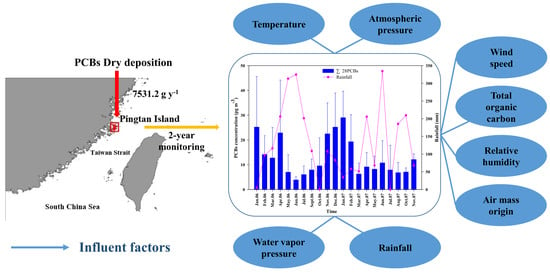Influential Factors and Dry Deposition of Polychlorinated Biphenyls (PCBs) in Atmospheric Particles at an Isolated Island (Pingtan Island) in Fujian Province, China
Abstract
:1. Introduction
2. Materials and Methods
2.1. Sampling Location and Air Sampling
2.2. Sample Pretreatment and Analysis
2.3. Quality Control and Quality Assurance (QA/QC)
2.4. Meteorological Parameters
2.5. Back Trajectories
2.6. Dry Deposition Fluxes
3. Results and Discussion
3.1. Characteristics of Atmospheric Concentrations
3.2. Seasonal Variations
3.3. Influential Factors
3.3.1. Meteorological Conditions
3.3.2. Influence of Total Organic Carbon and Possible Sources
3.3.3. Influence of Air Mass Origin
3.4. Dry Deposition
4. Conclusions
Supplementary Materials
Acknowledgments
Author Contributions
Conflicts of Interest
References
- Galbánmalagón, C.; Berrojalbiz, N.; Ojeda, M.J.; Dachs, J. The oceanic biological pump modulates the atmospheric transport of persistent organic pollutants to the arctic. Nat. Commun. 2012, 3, 862–870. [Google Scholar] [CrossRef] [PubMed]
- Kallenborn, R.; Oehme, M.; Wynn-Williams, D.D.; Schlabach, M.; Harris, J. Ambient air levels and atmospheric long-range transport of persistent organochlorines to Signy Island, Antarctica. Sci. Total Environ. 1998, 220, 167–180. [Google Scholar] [CrossRef]
- Breivik, K.; Sweetman, A.; Pacyna, J.M.; Jones, K.C. Towards a global historical emission inventory for selected PCB congeners—A mass balance approach: 1. Global production and consumption. Sci. Total Environ. 2002, 290, 181–198. [Google Scholar] [CrossRef]
- Xing, Y.; Lu, Y.; Dawson, R.W.; Shi, Y.; Zhang, H.; Wang, T.; Liu, W.; Ren, H. A spatial temporal assessment of pollution from PCBs in China. Chemosphere 2005, 60, 731–739. [Google Scholar] [CrossRef] [PubMed]
- Zhang, Z.; Liu, L.; Li, Y.F.; Wang, D.; Jia, H.; Harner, T.; Sverko, E.; Wan, X.; Xu, D.; Ren, N. Analysis of polychlorinated biphenyls in concurrently sampled Chinese air and surface soil. Environ. Sci. Technol. 2008, 42, 6514–6518. [Google Scholar] [CrossRef] [PubMed]
- Li, Y.F.; Harner, T.; Liu, L.; Zhang, Z.; Ren, N.Q.; Jia, H.; Ma, J.; Sverko, E. Polychlorinated biphenyls in global air and surface soil: Distributions, air−soil exchange, and fractionation effect. Environ. Sci. Technol. 2010, 44, 2784–2790. [Google Scholar] [CrossRef] [PubMed]
- Wang, Y.; Wu, X.; Hou, M.; Zhao, H.; Chen, R.; Luo, C.; Zhang, G. Factors influencing the atmospheric concentrations of PCBs at an abandoned e-waste recycling site in South China. Sci. Total Environ. 2016, 578, 34–39. [Google Scholar] [CrossRef] [PubMed]
- Cui, S.; Qi, H.; Liu, L.Y.; Song, W.W.; Ma, W.L.; Jia, H.L.; Ding, Y.S.; Li, Y.F. Emission of unintentionally produced polychlorinated biphenyls (up-PCBs) in China: Has this become the major source of PCBs in Chinese air? Atmos. Environ. 2013, 67, 73–79. [Google Scholar] [CrossRef]
- Friedman, C.L.; Selin, N.E. Pcbs in the arctic atmosphere: Determining important driving forces using a global atmospheric transport model. Atmos. Chem. Phys. 2016, 15, 30857–30894. [Google Scholar] [CrossRef]
- Shunthirasingham, C.; Gawor, A.; Hung, H.; Brice, K.A.; Su, K.; Alexandrou, N.; Dryfhout-Clark, H.; Backus, S.; Sverko, E.; Shin, C. Atmospheric concentrations and loadings of organochlorine pesticides and polychlorinated biphenyls in the canadian great lakes basin (GLB): Spatial and temporal analysis (1992–2012). Environ. Pollut. 2016, 217, 124–133. [Google Scholar] [CrossRef] [PubMed]
- Breivik, K.; Sweetman, A.; Pacyna, J.M.; Jones, K.C. Towards a global historical emission inventory for selected PCB congeners—A mass balance approach: 3. An update. Sci. Total Environ. 2007, 377, 296–307. [Google Scholar] [CrossRef] [PubMed]
- Castro-Jiménez, J.; Dueri, S.; Eisenreich, S.J.; Mariani, G.; Skejo, H.; Umlauf, G.; Zaldívar, J.M. Polychlorinated biphenyls (PCBs) in the atmosphere of sub-alpine Northern Italy. Environ. Pollut. 2009, 157, 1024–1032. [Google Scholar] [CrossRef] [PubMed]
- Gai, N.; Pan, J.; Tang, H.; Chen, S.; Chen, D.; Zhu, X.; Lu, G.; Yang, Y. Organochlorine pesticides and polychlorinated biphenyls in surface soils from ruoergai high altitude prairie, east edge of qinghai-tibet plateau. Sci. Total Environ. 2014, 478, 90–97. [Google Scholar] [CrossRef] [PubMed]
- Wania, F.; Mackay, D. Global fractionation and cold condensation of low volatility organochlorine compounds in Polar Regions. Ambio 1993, 22, 10–18. [Google Scholar]
- Ding, S.; Dong, F.; Wang, B. Polychlorinated biphenyls and organochlorine pesticides in atmospheric particulate matter of northern china: Distribution, sources, and risk assessment. Environ. Sci. Pollut. Res. 2015, 22, 1–11. [Google Scholar] [CrossRef] [PubMed]
- Wang, H.S.; Zhao, Y.G.; Man, Y.B. Oral bioaccessibility and human risk assessment of organochlorine pesticides (OCPs) via fish consumption, using an in vitro gastrointestinal model. Food Chem. 2011, 127, 1673–1679. [Google Scholar] [CrossRef]
- Castro-Jiménez, J.; Mariani, G.; Vives, I.; Skejo, H.; Umlauf, G.; Zaldívar, J.M.; Dueri, S.; Messiaen, G.; Laugier, T. Atmospheric concentrations, occurrence and deposition of persistent organic pollutants (POPs) in a mediterranean coastal site (Etang de Thau, France). Environ. Pollut. 2011, 159, 1948–1956. [Google Scholar] [CrossRef] [PubMed]
- Die, Q.; Nie, Z.; Liu, F.; Tian, Y.; Fang, Y.; Gao, H.; Tian, S.; He, J.; Huang, Q. Seasonal variations in atmospheric concentrations and gas–particle partitioning of PCDD/Fs and dioxin-like PCBs around industrial sites in Shanghai, China. Atmos. Environ. 2015, 119, 220–227. [Google Scholar] [CrossRef]
- Li, Y.M.; Jiang, G.B.; Wang, Y.W.; Pu, W.; Zhang, Q.H. Concentrations, profiles and gas-particle partitioning of PCDD/Fs, PCBs and PBDEs in the ambient air of an e-waste dismantling area, Southeast China. Sci. Bull. 2008, 53, 521–528. [Google Scholar] [CrossRef]
- Xing, G.H.; Chan, J.K.; Leung, A.O.; Wu, S.C.; Wong, M.H. Environmental impact and human exposure to PCBs in Guiyu, an electronic waste recycling site in China. Environ. Int. 2009, 35, 76–82. [Google Scholar] [CrossRef] [PubMed]
- Zhang, Z.L.; Hong, H.S.; Zhou, J.L.; Huang, J.; Yu, G. Fate and assessment of persistent organic pollutants in water and sediment from Minjiang River estuary, Southeast China. Chemosphere 2003, 52, 1423–1430. [Google Scholar] [CrossRef]
- Fu, J.; Mai, B.; Sheng, G.; Zhang, G.; Wang, X.; Peng, P.A.; Xiao, X.; Ran, R.; Cheng, F.; Peng, X. Persistent organic pollutants in environment of the pearl river delta, china: An overview. Chemosphere 2003, 52, 1411–1422. [Google Scholar] [CrossRef]
- Wang, H.S.; Du, J.; Leung, H.M.; Leung, A.O.W.; Liang, P.; Giesy, J.P.; Wong, C.K.C.; Wong, M.H. Distribution and source apportionments of polychlorinated biphenyls (PCBs) in mariculture sediments from the Pearl River delta, South China. Mar. Pollut. Bull. 2011, 63, 516–522. [Google Scholar] [CrossRef] [PubMed]
- Xing, Y.; Lü, Y.L.; Liu, W.B.; Shi, Y.J.; Luo, W.; Ren, H.C. Assessment of PCB pollution in spatial distribution and analysis of the PCB sources in sediments in China. Environ. Sci. 2006, 27, 228–234. [Google Scholar]
- He, J.; Balasubramanian, R. Semi-volatile organic compounds (SVOCs) in ambient air and rainwater in a tropical environment: Concentrations and temporal and seasonal trends. Chemosphere 2010, 78, 742–751. [Google Scholar] [CrossRef] [PubMed]
- Dvorská, A.; Lammel, G.; Holoubek, I. Recent trends of persistent organic pollutants in air in central Europe—Air monitoring in combination with air mass trajectory statistics as a tool to study the effectivity of regional chemical policy. Atmos. Environ. 2009, 43, 1280–1287. [Google Scholar] [CrossRef]
- Mi, H.H.; Wu, Z.S.; Lin, L.F.; Lai, Y.C.; Lee, Y.Y.; Wang, L.C.; Chang-Chien, G.P. Atmospheric dry deposition of polychlorinated dibenzo-p-dioxins/dibenzofurans (PCDD/Fs) and polychlorinated biphenyls (PCBs) in Southern Taiwan. Aerosol Air Qual. Res. 2012, 12, 1016–1029. [Google Scholar] [CrossRef]
- Yue, Q.; Zhang, K.; Zhang, B.Z.; Li, S.M.; Zeng, E.Y. Occurrence, phase distribution and depositional intensity of dichlorodiphenyltrichloroethane (DDT) and its metabolites in air and precipitation of the Pearl River delta, China. Chemosphere 2011, 84, 446–451. [Google Scholar] [CrossRef] [PubMed]
- Lee, W.J.; Su, C.C.; Sheu, H.L.; Fan, Y.C.; Chao, H.R.; Fang, G.C. Monitoring and modeling of PCB dry deposition in Urban area. J. Hazard. Mater. 1996, 49, 57–88. [Google Scholar] [CrossRef]
- Lee, W.J.; Lewis, S.J.L.; Chen, Y.Y.; Wang, Y.F.; Sheu, H.L.; Su, C.C.; Fan, Y.C. Polychlorinated biphenyls in the ambient air of petroleum refinery, urban and rural areas. Atmos. Environ. 1996, 30, 2371–2378. [Google Scholar] [CrossRef]
- Bozlaker, A.; Odabasi, M.; Muezzinoglu, A. Dry deposition and soil-air gas exchange of polychlorinated biphenyls (PCBs) in an industrial area. Environ. Pollut. 2008, 156, 784–793. [Google Scholar] [CrossRef] [PubMed]
- Yang, G.S.; Ma, L.L.; Xu, D.D.; Li, J.; Gong, C.; Zhang, B.; Chen, Y.; Chai, Z.F. Characterization of polychlorinated biphenyls in summer precipitation and atmosphere in Shijingshan district, Beijing. China Environ. Sci. 2012, 32, 1234–1240. [Google Scholar]
- Pan, J.; Yang, Y.L.; Zhang, G.; Shi, J.L.; Zhu, X.H.; Li, Y.; Yu, H.Q. Simultaneous observation of seasonal variations of beryllium-7 and typical pops in near-surface atmospheric aerosols in Guangzhou, China. Atmos. Environ. 2011, 45, 3371–3380. [Google Scholar] [CrossRef]
- Zhao, J.P.; Zhang, F.W.; Chen, J.S.; Ya, X.U. Pollution characteristics of atmospheric polychlorinated biphenyls in coastal city. Environ. Sci. Technol. 2011, 34, 59–65. [Google Scholar]
- Yeo, H.G.; Choi, M.; Chun, M.Y.; Kim, T.W.; Cho, K.C.; Sunwoo, Y. Concentration characteristics of atmospheric PCBs for urban and rural area, Korea. Sci. Total Environ. 2004, 324, 261–270. [Google Scholar] [CrossRef] [PubMed]
- Mandalakis, M.; Tsapakis, M.; Tsoga, A.; Stephanou, E.G. Gas–particle concentrations and distribution of aliphatic hydrocarbons, PAHs, PCBs and PCDD/Fs in the atmosphere of Athens (Greece). Atmos. Environ. 2002, 36, 4023–4035. [Google Scholar] [CrossRef]
- Wang, Z.; Na, G.; Gao, H.; Wang, Y.; Yao, Z. Atmospheric concentration characteristics and gas/particle partitioning of PCBs from the north pacific to the Arctic Ocean. Acta Oceanol. Sin. 2014, 33, 32–39. [Google Scholar] [CrossRef]
- Kim, K.S.; Masunaga, S. Behavior and source characteristic of PCBs in urban ambient air of Yokohama, Japan. Environ. Pollut. 2005, 138, 290–298. [Google Scholar] [CrossRef] [PubMed]
- Shin, S.K.; Jin, G.Z.; Kim, W.I.; Kim, B.H.; Hwang, S.M.; Hong, J.P.; Park, J.S. Nationwide monitoring of atmospheric PCDD/Fs and dioxin-like PCBs in South Korea. Chemosphere 2011, 83, 1339–1344. [Google Scholar] [CrossRef] [PubMed]
- Luo, J.; Cui, Z.J.; Du, S.Y.; Fan, G.L. Temporal variation and meteorological dependence of polychlorinated biphenyls in atmospheric pm10 of Jinan, China. Adv. Mater. Res. 2013, 780, 1250–1253. [Google Scholar] [CrossRef]
- Wang, Y.; Luo, C.; Wang, S.; Cheng, Z.; Li, J.; Zhang, G. The abandoned e-waste recycling site continued to act as a significant source of polychlorinated biphenyls: An in situ assessment using fugacity samplers. Environ. Sci. Technol. 2016, 50, 8623–8630. [Google Scholar] [CrossRef] [PubMed]
- Simcik, M.F.; Franz, T.P.; Zhang, H.; Eisenreich, S.J. Gas-particle partitioning of PCBs and PAHs in the Chicago urban and adjacent coastal atmosphere: States of equilibrium. Environ. Sci. Technol. 2015, 32, 251–257. [Google Scholar] [CrossRef]
- Shen, L.; Wania, F.; Lei, Y.D.; Teixeira, C.; Muir, D.C.; Xiao, H. Polychlorinated biphenyls and polybrominated diphenyl ethers in the North American atmosphere. Environ. Pollut. 2006, 144, 434–444. [Google Scholar] [CrossRef] [PubMed]
- Chen, S.J.; Hsieh, L.T.; Hwang, P.S. Concentration, phase distribution, and size distribution of atmospheric polychlorinated biphenyls measured in Southern Taiwan. Environ. Int. 1996, 22, 411–423. [Google Scholar] [CrossRef]
- Gouin, T.; Thomas, G.O.; Cousins, I.; Barber, J.; Mackay, D.; Jones, K.C. Air-surface exchange of polybrominated diphenyl ethers and polychlorinated biphenyls. Environ. Sci. Technol. 2002, 36, 1426–1434. [Google Scholar] [CrossRef] [PubMed]
- He, J.; Balasubramanian, R.; Burger, D.F.; Hicks, K.; Kuylenstierna, J.C.I.; Palani, S. Dry and wet atmospheric deposition of nitrogen and phosphorus in Singapore. Atmos. Environ. 2011, 45, 2760–2768. [Google Scholar] [CrossRef]
- Qu, C.; Yang, D.; Zhang, J.; Chen, W.; Sandy, E.H.; Xing, X.; Qi, S.; Huang, H.; Yohannes, H.K.; Yang, J. Risk assessment and influence factors of organochlorine pesticides (OCPs) in agricultural soils of the hill region: A case study from Ningde, Southeast China. J. Geochem. Explor. 2015, 149, 43–51. [Google Scholar] [CrossRef]
- Gao, J.; Zhou, H.; Pan, G.; Wang, J.; Chen, B. Factors influencing the persistence of organochlorine pesticides in surface soil from the region around the Hongze Lake, China. Sci. Total Environ. 2013, 443, 7–13. [Google Scholar] [CrossRef] [PubMed]
- Widory, D. Combustibles, fuels and their combustion products: A view through carbon isotopes. Combust. Theory Model. 2006, 10, 831–841. [Google Scholar] [CrossRef]
- Gleason, J.D.; Kyser, T.K. Stable isotope compositions of gases and vegetation near naturally burning coal. Nature 1984, 307, 254–257. [Google Scholar] [CrossRef]
- Fry, B.; Sherr, E.B. δ13C Measurements as Indicators of Carbon Flow in Marine and Freshwater Ecosystems; Springer: New York, NY, USA, 1989; pp. 196–229. [Google Scholar]
- Moura, J.M.S.; Martens, C.S.; Moreira, M.Z.; Lima, R.L.; Sampaio, I.C.G.; Mendlovitz, H.P.; Menton, M.C. Spatial and seasonal variations in the stable carbon isotopic composition of methane in stream sediments of Eastern Amazonia. Tellus Ser. B Chem. Phys. Meteorol. 2008, 60, 21–31. [Google Scholar] [CrossRef]
- Cao, J.J.; Chow, J.C.; Tao, J.; Lee, S.C.; Watson, J.G.; Ho, K.F.; Wang, G.H.; Zhu, C.S.; Han, Y.M. Stable carbon isotopes in aerosols from Chinese cities: Influence of fossil fuels. Atmos. Environ. 2011, 45, 1359–1363. [Google Scholar] [CrossRef]
- Jin, G.; Cong, L.; Fang, Y.; Li, J.; He, M.; Li, D. Polycyclic aromatic hydrocarbons in air particulates and its effect on the Tumen River area, Northeast China. Atmos. Environ. 2012, 60, 298–304. [Google Scholar] [CrossRef]
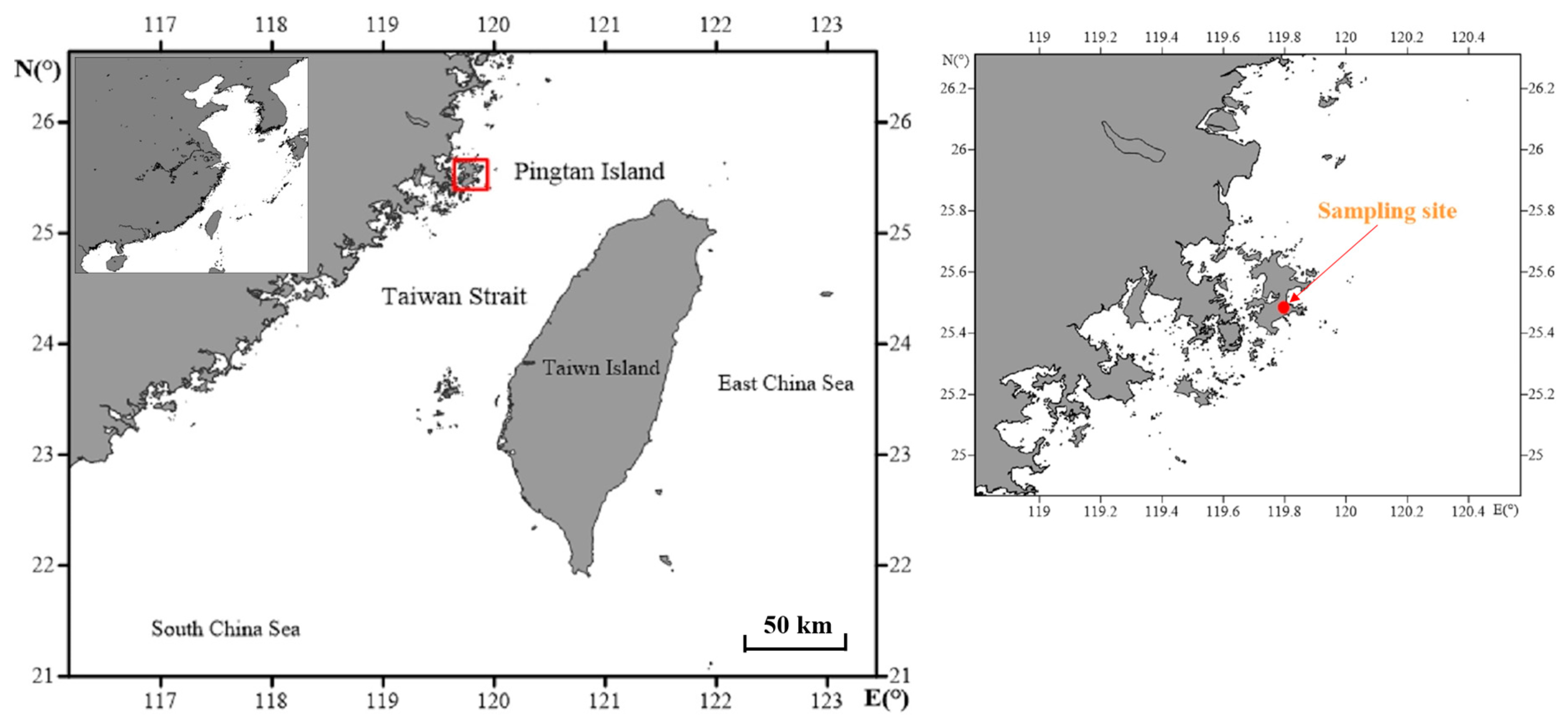
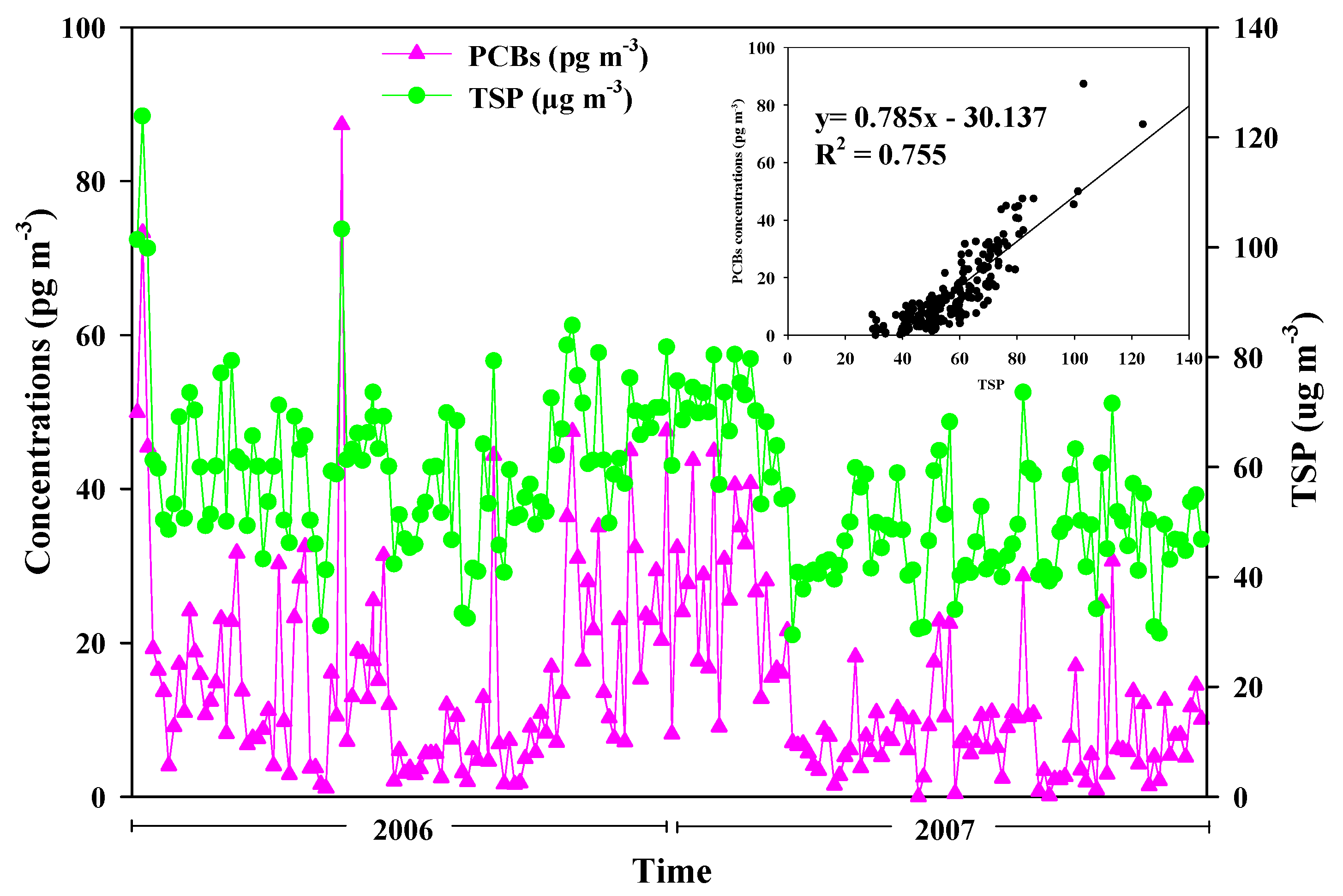

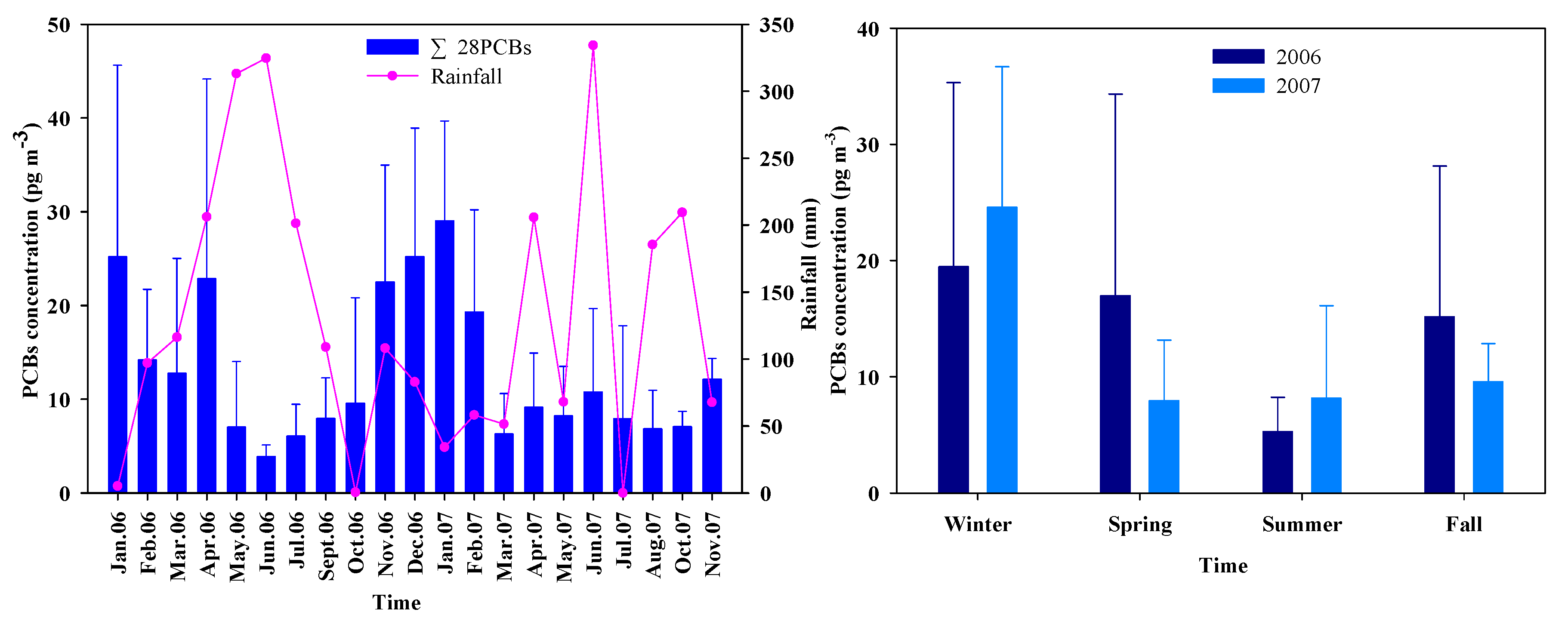
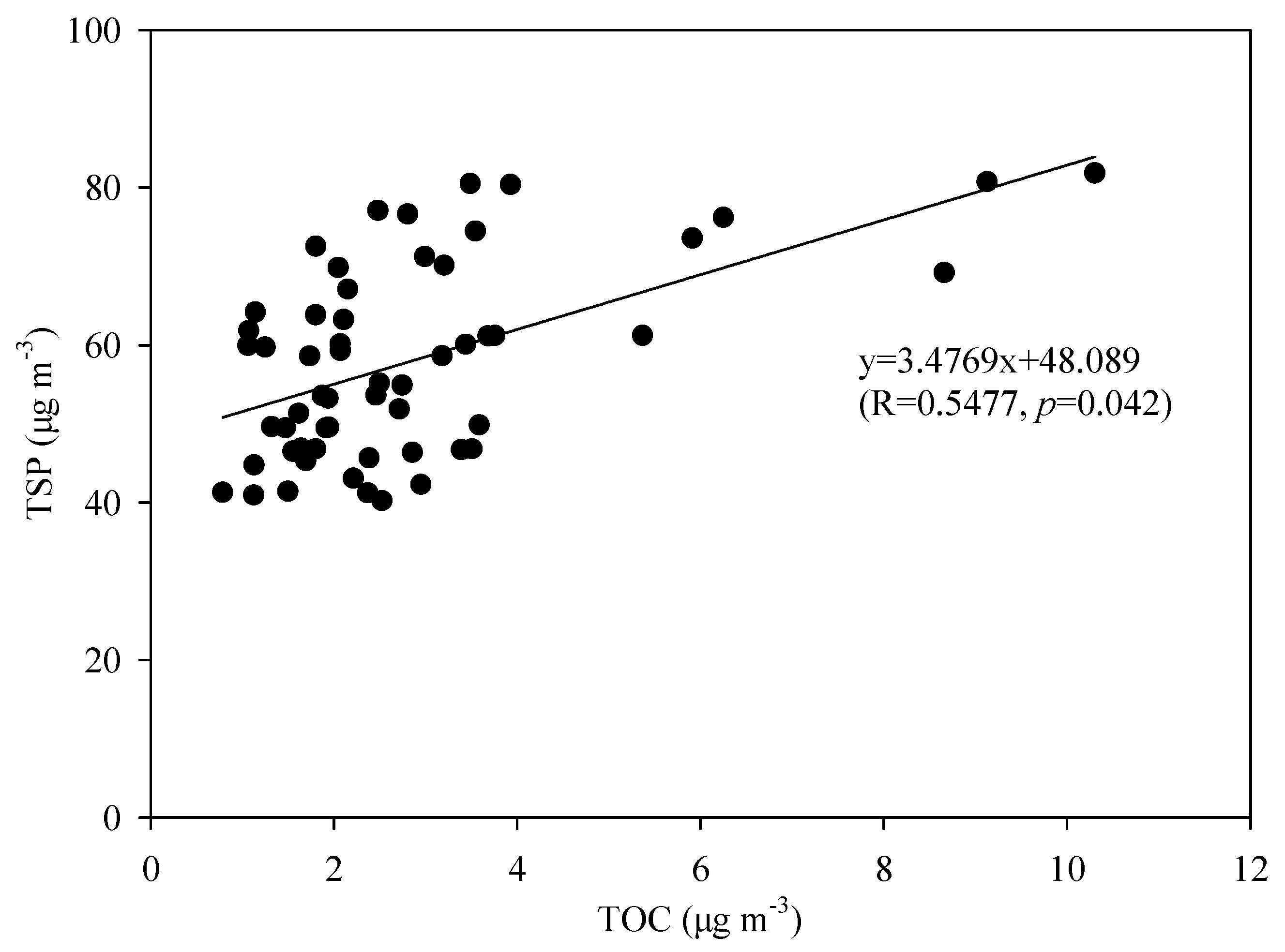
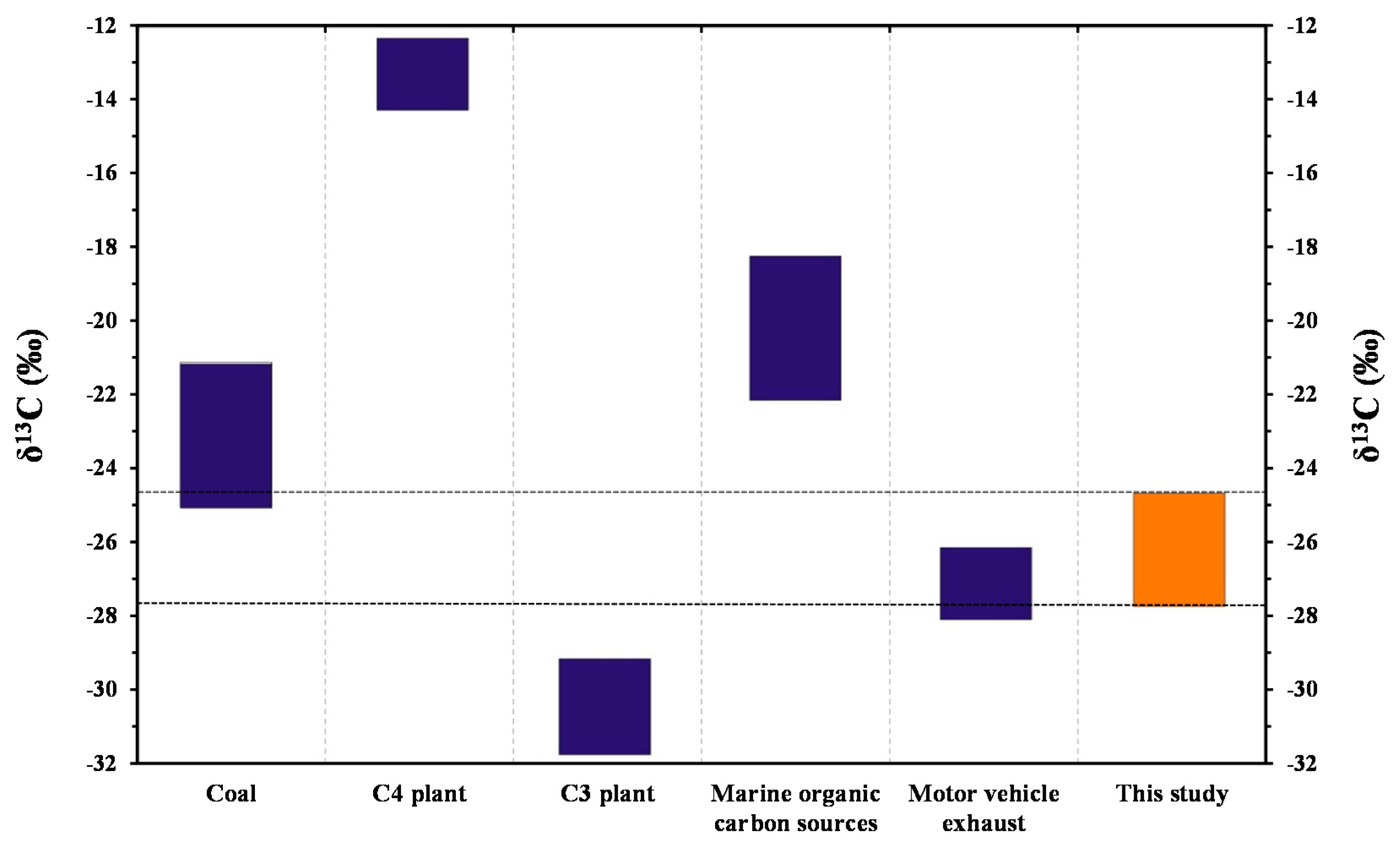
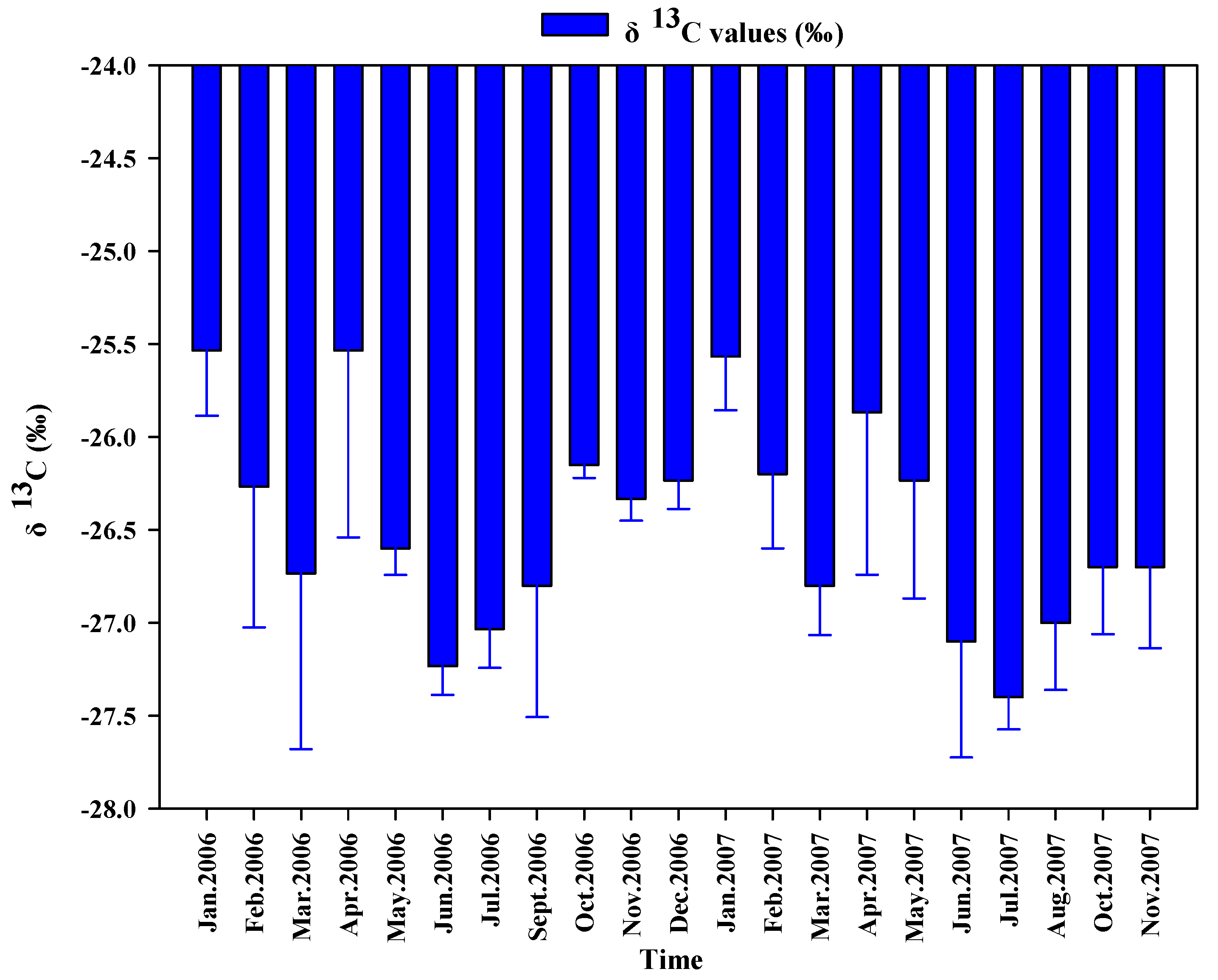
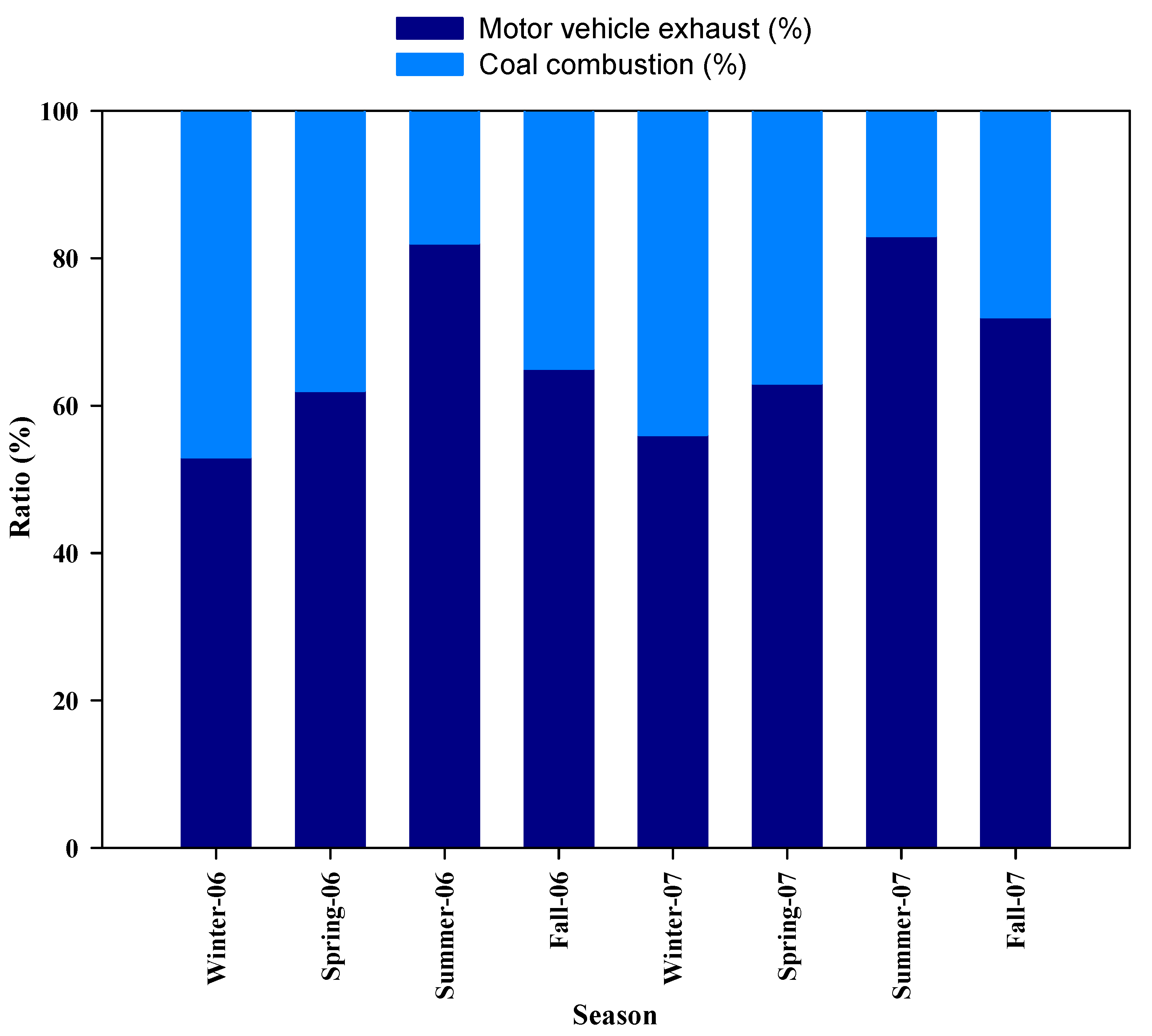
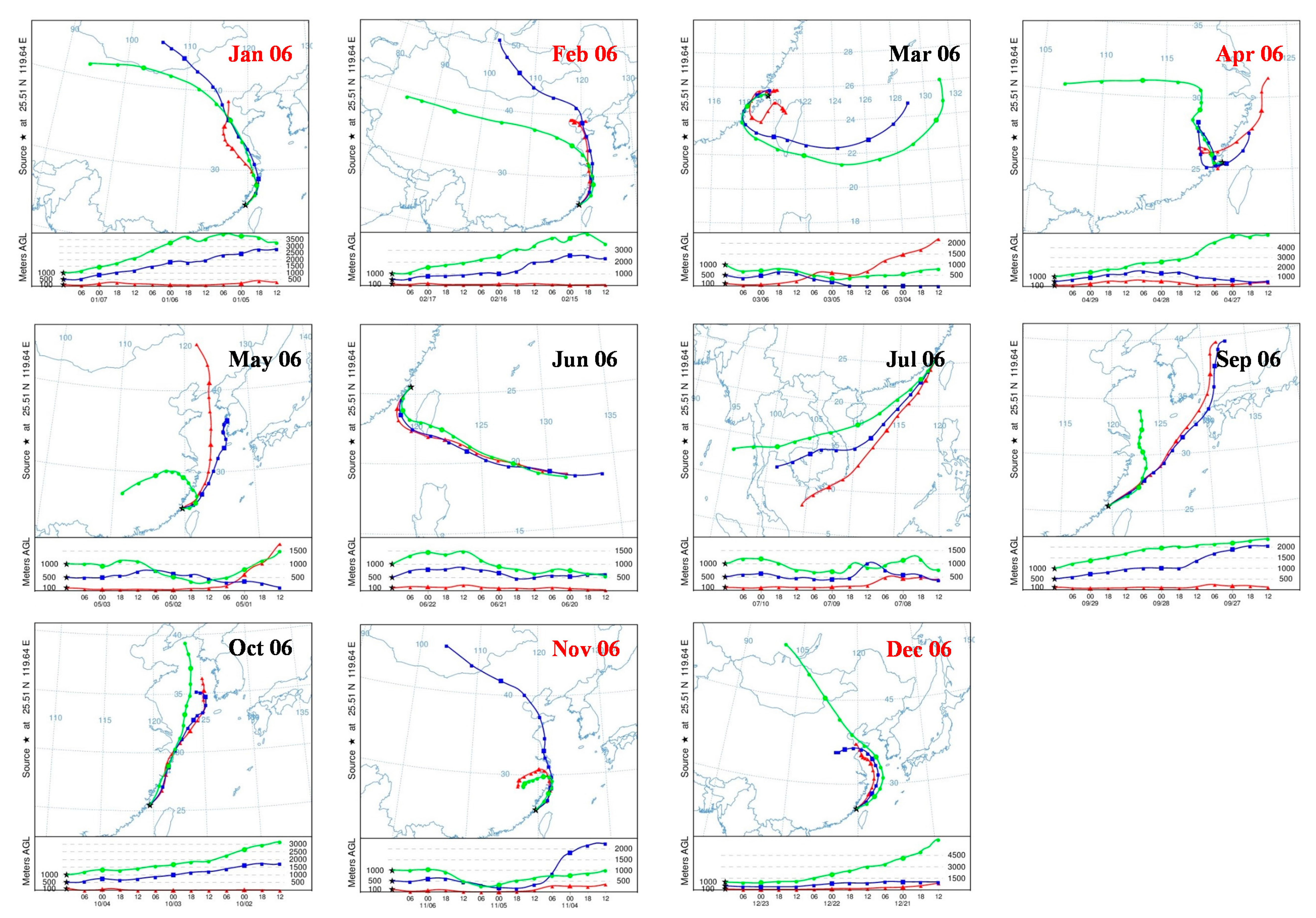
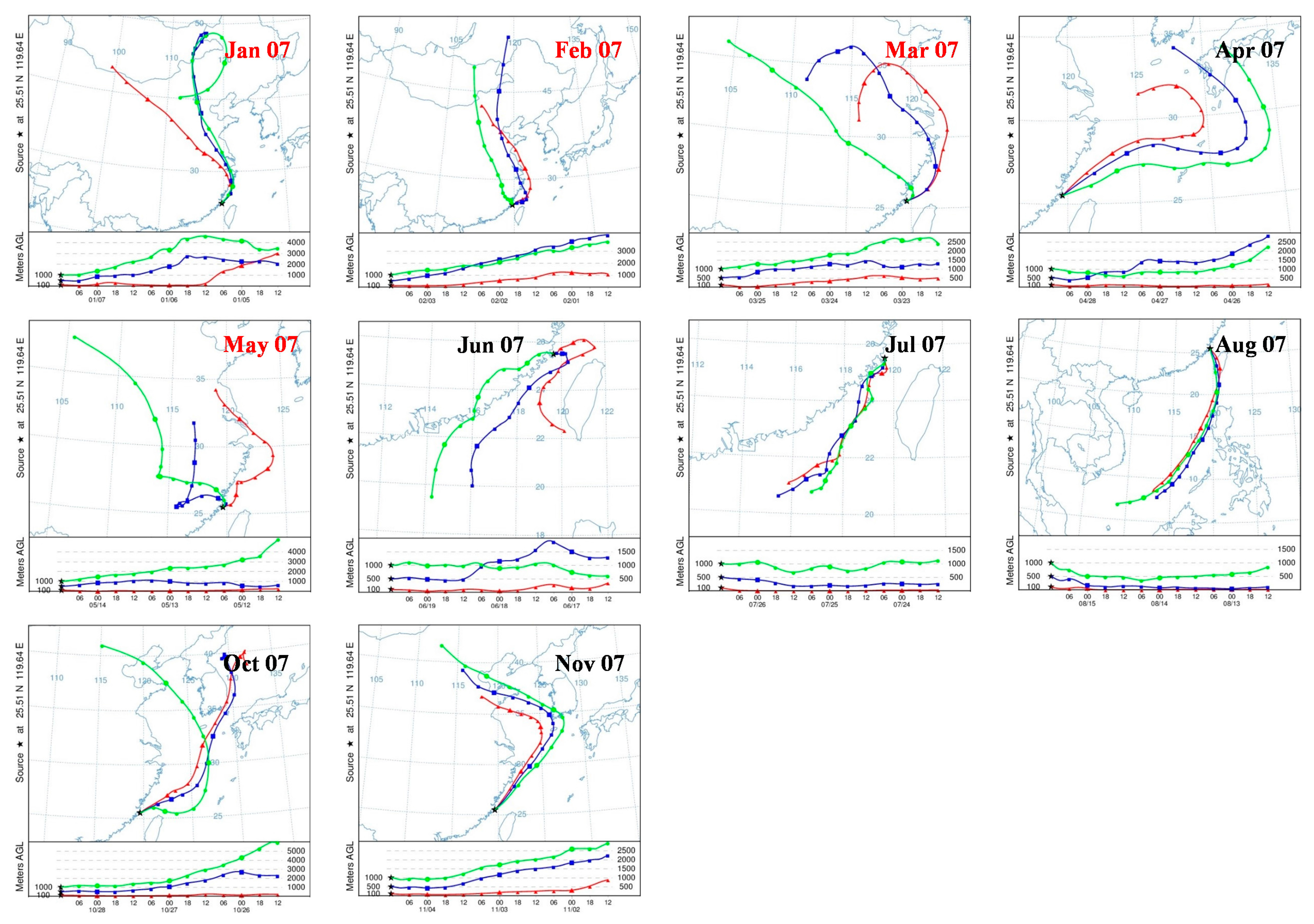
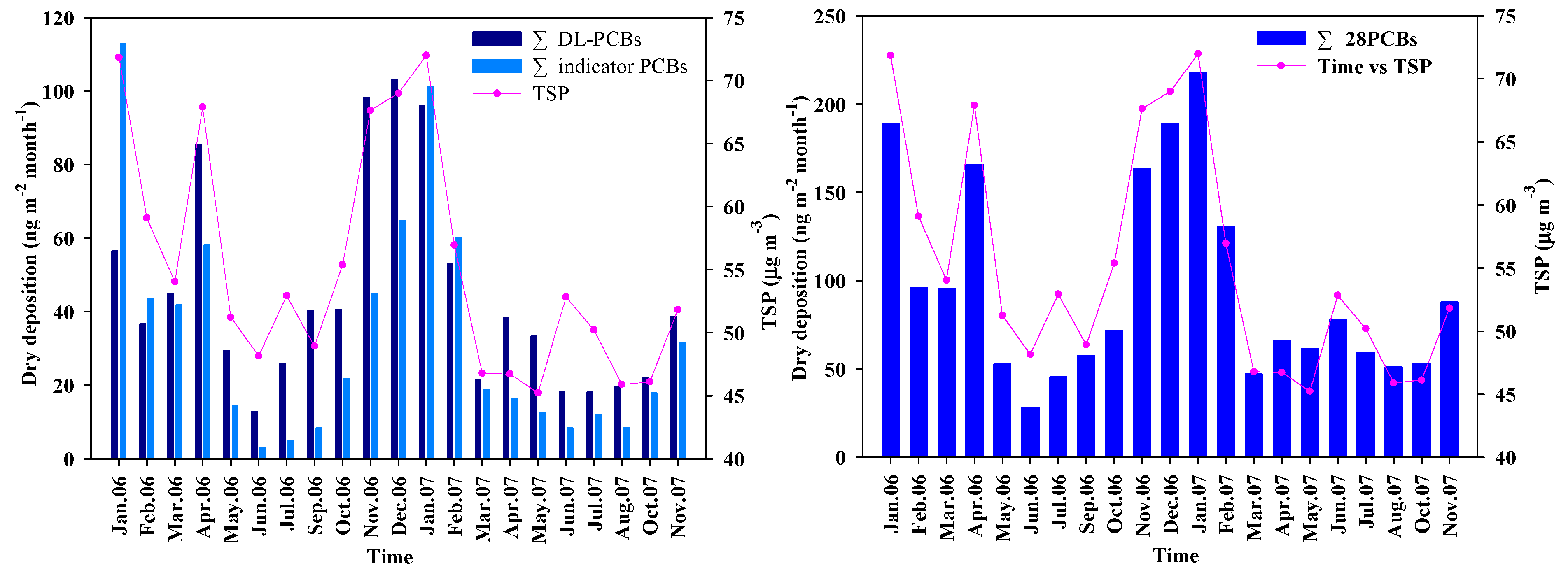
| Location | Region | Time | Number of PCB Congeners | Concentration | Reference |
|---|---|---|---|---|---|
| Taizhou, China | Industrial | 2007 | 18 | 287 | [19] |
| Guiyu, China | Industrial | 2008 | 36 | 14800 | [20] |
| Taiwan | Industrial | 1996 | 18500 | [30] | |
| Izmir, Turkey | Industrial | Summer, 2004 | 41 | 3370 | [31] |
| Izmir, Turkey | Industrial | Winter, 2005 | 41 | 1164 | [31] |
| Beijing, China | urban | Summer, 2009 | 32 | 113.6 | [32] |
| Guangzhou, China | urban | 2006–2007 | 33 | 317.6 | [33] |
| Xiamen, China | urban | 2008–2009 | 28 | 1.28–606.16 | [34] |
| Korea | urban | 1999–2000 | 38 | 130.4 | [35] |
| Korea | rural | 1999–2000 | 38 | 39.7 | [35] |
| Mediterranean | Coastal area | 2007–2008 | 18 | 2.63 | [17] |
| Lake Maggiore | Coastal area | 2005–2006 | 7 | 3–10 | [12] |
| Athens, Greece | Coastal area | 2000 | 54 | 4.00 | [36] |
| Arctic Ocean | Ocean | 2012 | 26 | 4.01 | [37] |
| Pingtan | Coastal area | 2006–2007 | 28 | 5.53 | This study |
| Location | Region | Time | Concentration | Reference |
|---|---|---|---|---|
| Shanghai, China | urban | Summer in 2013 | 1.08–17.0 | [18] |
| Shanghai, China | urban | Winter in 2013 | 5.26–55.90 | [18] |
| Yokohama, Japan | urban | March, 2002 and Feburuary, 2003 | 2.00–14.00 | [38] |
| South Korea | urban | 2008 | ND–16.00 | [39] |
| Taizhou, China | Industrial | 2007 | 50–859 | [19] |
| Etang de Thau, France | coastal | 2007–2008 | 2.77–103.30 | [17] |
| Pingtan, China | coastal | 2006 | 43.82 | This study |
| Pingtan, China | coastal | 2007 | 2.28 | This study |
| PCB | WS | AP | T | WVP | RH | TOC |
|---|---|---|---|---|---|---|
| 8 | - | - | - | 0.297 b | - | −0.291 a |
| 18 | - | - | - | - | −0.170 a | - |
| 28 | - | - | - | - | - | 0.497 b |
| 52 | - | - | - | - | - | - |
| 44 | - | - | - | - | - | - |
| 66 | - | - | - | - | 0.142 a | - |
| 101 | - | - | - | - | - | - |
| 81 | - | - | - | - | - | - |
| 77 | - | 0.236 b | - | −0.143 a | −0.154 | - |
| 123 | - | - | - | - | - | - |
| 118 | - | −0.152 a | 0.156 a | 0.167 a | - | - |
| 114 | - | 0.181 b | −0.197 b | −0.212 b | - | - |
| 153 | - | - | - | - | - | 0.324 a |
| 105 | 0.162 a | 0.195 b | - | −0.147 a | −0.233 b | - |
| 138 | 0.165 a | 0.56 b | −0.544 b | −0.555 b | −0.342 b | - |
| 126 | - | - | - | - | - | - |
| 187 | 0.160 a | 0.215 b | −0.290 b | −0.278 b | - | 0.304 a |
| 128 + 167 | - | - | - | - | - | - |
| 156 | - | 0.36 b | −0.305 b | −0.313 b | −0.299 b | - |
| 157 | - | - | - | - | - | - |
| 180 | - | −0.146 a | - | - | - | 0.272 a |
| 169 | - | - | - | - | −0.235 b | - |
| 170 | 0.246 b | 0.156 a | −0.152 a | −0.156 a | −0.180 b | - |
| 189 | - | 0.168 a | −0.223 b | −0.211 b | 0.260 a | |
| 195 | - | 0.432 b | −0.432 b | −0.448 b | −0.150 a | 0.304 a |
| 206 | - | - | −0.186 b | −0.159 a | - | 0.265 a |
| 209 | - | - | - | - | - | - |
| ∑DL-PCBs | - | 0.256 b | −0.224 b | −0.241 b | - | - |
| ∑indicator PCBs | 0.144 b | 0.486 b | −0.479 b | −0.485 b | −0.289 b | - |
| ∑28PCBs | - | 0.398 b | −0.361 b | −0.371 b | −0.230 b | - |
| ∑DL-PCBs | ∑indicator PCBs | ∑28PCBs | |
|---|---|---|---|
| 2006 | 698.5 | 546.6 | 1436.7 |
| 2007 | 461.8 | 362.0 | 1073.7 |
© 2018 by the authors. Licensee MDPI, Basel, Switzerland. This article is an open access article distributed under the terms and conditions of the Creative Commons Attribution (CC BY) license (http://creativecommons.org/licenses/by/4.0/).
Share and Cite
Lao, Q.; Jiao, L.; Chen, F.; Chen, L.; Sun, X. Influential Factors and Dry Deposition of Polychlorinated Biphenyls (PCBs) in Atmospheric Particles at an Isolated Island (Pingtan Island) in Fujian Province, China. Atmosphere 2018, 9, 59. https://doi.org/10.3390/atmos9020059
Lao Q, Jiao L, Chen F, Chen L, Sun X. Influential Factors and Dry Deposition of Polychlorinated Biphenyls (PCBs) in Atmospheric Particles at an Isolated Island (Pingtan Island) in Fujian Province, China. Atmosphere. 2018; 9(2):59. https://doi.org/10.3390/atmos9020059
Chicago/Turabian StyleLao, Qibin, Liping Jiao, Fajin Chen, Liqi Chen, and Xia Sun. 2018. "Influential Factors and Dry Deposition of Polychlorinated Biphenyls (PCBs) in Atmospheric Particles at an Isolated Island (Pingtan Island) in Fujian Province, China" Atmosphere 9, no. 2: 59. https://doi.org/10.3390/atmos9020059




